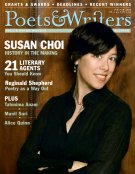On a recent afternoon, I walked up Park Avenue from my office in downtown Manhattan to interview the literary agent Lynn Nesbit. The agency she founded almost twenty years ago, Janklow & Nesbit Associates, occupies an entire floor of a large office building on the corner of Fifty-seventh Street. In the elevator, I couldn't help but think of the celebrated authors who must have taken the same ride to visit Nesbit, and my mind wandered to some of their memorable opening lines: "We were somewhere around Barstow on the edge of the desert when the drugs began to take hold" (Hunter S. Thompson). "That's good thinking there, Cool Breeze" (Tom Wolfe). "It is easy to see the beginnings of things, and harder to see the ends" (Joan Didion).
The first novel is the easiest to sell. But if it doesn't do well, you're up a creek. You have to reposition the author...because the publisher doesn't want to take another bath.
For Nesbit, the beginnings of things were no less evocative. Raised in the small town of Dundee, Illinois, and educated at Northwestern, the Sorbonne, and in the Radcliffe Publishing Program, she came to New York in the fall of 1960 and took the first job she was offered. The position, as an editorial apprentice at Ladies' Home Journal, was unsatisfying. She badgered Sterling Lord—even then a legendary book agent—for a job as his assistant, but he had nothing permanent to offer. So, in her spare time, she read manuscripts for him in French. Eventually a position opened up, and Nesbit leapt at the opportunity, despite a salary cut of ten dollars a week.
She worked her way up to being an agent in Lord's office; her early clients included Donald Barthelme, Michael Crichton, Frederick Exley, Hunter S. Thompson, and Tom Wolfe. In 1965, she left Sterling Lord to start the agency that would become International Creative Management; in 1989 she joined forces with Mort Janklow to found another new agency, Janklow & Nesbit Associates, which remains one of the most successful in New York. Over the years she has guided the careers of luminaries such as John Cheever, Joan Didion, William H. Gass, Shirley Hazzard, and Gore Vidal; younger writers such as Ann Beattie, Stephen L. Carter, Jeffrey Eugenides, Jayne Anne Phillips, Richard Price, and Scott Spencer; commercial superstars such as Robin Cook, Richard Preston, and Anne Rice; and nonfiction heavyweights such as Robert Caro, Jimmy Carter, Jonathan Kozol, and Gay Talese.
In this, the first in a new series of interviews with veteran book editors, publishers, and agents, Nesbit talks about her life, her career, and her authors, reflecting on the past, present, and future of the book industry and what writers can do to thrive in today's publishing world.
Why don't you start by telling me a little about your background. Where did you grow up?
I grew up in Illinois, in a town thirty-five miles northwest of Chicago called Dundee.
And you went to Northwestern?
I went to Northwestern because I wanted to be a drama major. But then I quickly learned, once I was involved in it, that I didn't want to do it. It was such a serious professional school. So I switched my major from theater to oral interpretation of literature. You'd do chamber theater, for example. You'd take Don Quixote and present it as a chamber theater piece. I was in a production and I played all of the women roles. Of course they were all variations on Dulcinea or his fantasy. It was an extremely good way to learn about the construction of a narrative. Because when you're breaking it apart, often you will characterize or have an actor play the narrator's role, so you learn a lot about voice.
What brought you to New York?
I always wanted to come to New York. When I was a child I used to listen to Grand Central Station—"Crossroads of a million private lives"—and think, "What could be more exciting than New York?" I was wandering through the English department my senior year at Northwestern and saw something about the Radcliffe Publishing Program. I thought, "Hmmm, I want to come to New York, I love to read books, this sounds like it's for me."
How did you get started in the industry?
At the Radcliffe program, they told you to take the first job you were offered because there were no jobs in publishing. They've been saying that for forty, fifty years. Sterling Lord was the agent who came to speak to the students, and I thought—I don't know why, I've thought about this over the years—but I thought, "Agent, that's what I want to do." But Sterling said he had nothing to offer. So I took the first job I got, which was as an editorial apprentice at Ladies' Home Journal. And I hated it. It just wasn't for me. So I kept hounding Sterling. And I read French quite well then. He was representing a couple of people who wrote in French, Tereska Torres and Juan Goytisolo. So I would read the books and write readers reports on them. And I hounded him. After three months at Ladies' Home Journal he offered me a job, for which I took a ten-dollars-a-week salary cut. I became his receptionist, his typist, his file clerk, and I had to weigh the packages and stamp all the letters.
Was Sterling Lord your primary mentor in the industry?
Sterling wasn't very interested in fiction, which helped me. He was immediately turning some things over to me. After I'd been working as his assistant for a month or two, he went to the Staten Island Writers Conference and came back and just threw these stories down on my desk. He said to read them and write to any of the writers I liked. One of the stories was "The Big Broadcast of 1938" by Donald Barthelme. And I read it and thought, "This is extraordinary." So I wrote, Dear Mr. Barthelme, I'm an agent and I just read this story and I think it's extraordinary and blah blah blah and I'd love to represent you. And he wrote back and said, "Fine." Now I don't think that happens today. There would be thirty agents crawling all over that story today—there are more agents than writers. And there are more writers than readers. I'm convinced of that.
Was Donald Barthelme your first big client?
Donald was very important because I sold the first story of his that I represented to the New Yorker. And he went on and became such an important force in the short story. But my first really big client—big in every way—was Tom Wolfe.
How did you meet him?
I pestered Byron Dobell at Esquire. I told him I wanted to meet Tom Wolfe. This was probably 1963. He'd published "Kandy-Kolored Tangerine-Flake Streamline Baby," the piece, in Esquire, and every other agent was after him too. I still ask him, to this day, why he signed with me. He says it's because I'm the only one who suggested he do a book, which is hard for me to imagine, but that's what he says. He was older than I was, and already a big deal, and I was just this kid.
The other big writer that I got young was Michael Crichton. I left Sterling Lord in, I think, 1965, to start a literary department for Marvin Josephson. It was called Marvin Josephson Associates. The head of his television department was a man named Ralph Mann, and he had a friend who had been a television agent at the William Morris office, whose daughter was Michael's first wife. This man was determined to find Michael the biggest agent there was. Of course he knew everyone. So Michael was interviewing all these people and he interviewed me, too. He was in medical school then and he had published one of his paperback John Lange thrillers, and he only had one other contract. So he came back for a second meeting and said—and this I remember very well—he said, "Let's grow up in the business together." So that was great.
Who was Marvin Josephson?
He was a very mild-mannered, shy, rather diffident television agent. He went around and bought these other agencies. He bought CMA, Monica McCall, Ashley-Famous. And this became ICM, this big corporate behemoth. He was never really an agent; he was a deal-maker, a buying agency.
And when you went there, you were the head of the agency right away?
I started the literary department for them at age twenty-five. They didn't have one. I went there and I was this kid. I was really young. I got there because I was dating an agent who worked for Marvin who said, "You should hire Lynn Nesbit." That's how I got there.
Tell me about some of the big personalities from those days in the book world.
Well, there were a lot of them. Bob Gottlieb was a genius.
From your perspective as an agent, what is his genius?
In the first place, he, like Michael Korda, who is my client actually, could read an eight-hundred-page manuscript in a night and come back to you the next day and give you a perfect analysis. Also, Bob never let a manuscript lay around. You would never hear from him, "Oh, I have seven manuscripts on my desk, I can't get to yours until a month from now." Bob also has such an incredibly big personality. And I always said that Bob has a big ego, but he can lend it to his writers, so they can share it. Bob Caro is one of my clients, and it's written into his contract that he has to have Bob as his editor.
A lot of people lament how the publishing industry has changed over the years. Your career seems to very much bridge all that—from the small independent shops to the corporatization of it all.
I say to Bob Gottlieb, who's still a very close personal friend, "You couldn't stand to be in publishing today." And he says, "I know." It is very corporatized. We all began to think about that in those days. What was going to happen? These big conglomerates, synergy, all that. People began to worry about it.








